

YamCha: Yet Another Multipurpose CHunk Annotator. $Id: index.html,v 1.37 2005/12/24 14:18:58 taku Exp $; Introduction YamCha is a generic, customizable, and open source text chunker oriented toward a lot of NLP tasks, such as POS tagging, Named Entity Recognition, base NP chunking, and Text Chunking.
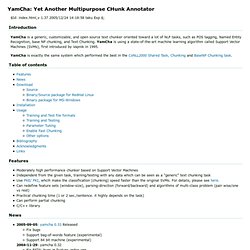
YamCha is using a state-of-the-art machine learning algorithm called Support Vector Machines (SVMs), first introduced by Vapnik in 1995. YamCha is exactly the same system which performed the best in the CoNLL2000 Shared Task, Chunking and BaseNP Chunking task. Free Science & Engineering software downloads. LIMA. 537_Paper. Comparateur online. Gate/plugins/Lang_Arabic/src/arabic/ SemanticFrontiers/ArabicNLP. نفطويه: تصنيف الكلمات العربية Naftawayh: Arabic Word Tagger. أدوات. QAMUS: Arabic Lexicography (Tim Buckwalter's website) Xerox Arabic Home Page. Welcome to the UPenn copy of Kenneth R.
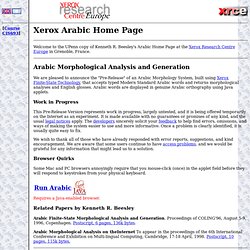
Beesley's Arabic Home Page at the Xerox Research Centre Europe in Grenoble, France. We are pleased to announce the "Pre-Release" of an Arabic Morphology System, built using Xerox Finite-State Technology, that accepts typed Modern Standard Arabic words and returns morphological analyses and English glosses. Arabic words are displayed in genuine Arabic orthography using Java applets. Work in Progress This Pre-Release Version represents work in progress, largely untested, and it is being offered temporarily on the Internet as an experiment. We wish to thank all of those who have already responded with error reports, suggestions, and kind encouragement. Browser Quirks Some Mac and PC browsers annoyingly require that you mouse-click (once) in the applet field before they will respond to keystrokes from your physical keyboard.
Open Xerox: Log In. Xerox Arabic Morphology: Input. Named Entity Tutorial. What is Named Entity Recognition?
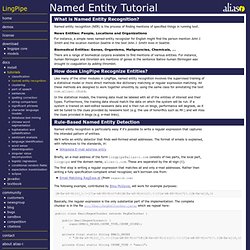
Named entity recognition (NER) is the process of finding mentions of specified things in running text. News Entities: People, Locations and Organizations For instance, a simple news named-entity recognizer for English might find the person mention John J. Smith and the location mention Seattle in the text John J. The Stanford Arabic NLP (Natural Language Processing) Group. Overview Arabic is the largest member of the Semitic language family and is spoken by nearly 500 million people worldwide.
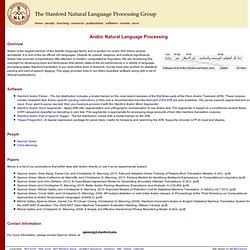
It is one of the six official UN languages. Despite its cultural, religious, and political significance, Arabic has received comparatively little attention in modern computational linguistics. Tregex/TregexGUI. About | Questions | Mailing lists | Contents | Download | Release history | FAQ About Tregex is a utility for matching patterns in trees, based on tree relationships and regular expression matches on nodes (the name is short for "tree regular expressions").
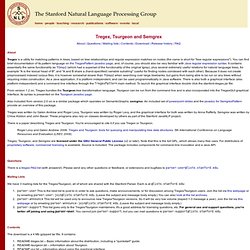
You can find brief documentation of its pattern language on the TregexPattern javadoc page, and, of course, you should also be very familiar with Java regular expression syntax. It contains essentially the same functionality as TGrep2 (which had a superset of the functionality of the original tgrep), plus several extremely useful relations for natural language trees, for example "A is the lexical head of B", and "A and B share a (hand-specified) variable substring" (useful for finding nodes coindexed with each other).
Stanford Arabic Part of Speech Tagger. Download | Mailing Lists | Extensions | Release history | FAQ Tokenization of raw text is a standard pre-processing step for many NLP tasks.
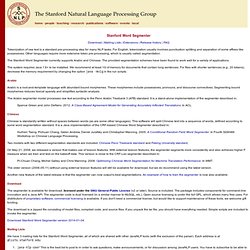
For English, tokenization usually involves punctuation splitting and separation of some affixes like possessives. Stanford Arabic Word Segmenter. Stanford Arabic Parser. About | Citing | Questions | Download | Included Tools | Extensions | Release history | Sample output | Online | FAQ A natural language parser is a program that works out the grammatical structure of sentences, for instance, which groups of words go together (as "phrases") and which words are the subject or object of a verb.

Probabilistic parsers use knowledge of language gained from hand-parsed sentences to try to produce the most likely analysis of new sentences. These statistical parsers still make some mistakes, but commonly work rather well. Their development was one of the biggest breakthroughs in natural language processing in the 1990s. You can try out our parser online. Package contents This package is a Java implementation of probabilistic natural language parsers, both highly optimized PCFG and lexicalized dependency parsers, and a lexicalized PCFG parser. As well as providing an English parser, the parser can be and has been adapted to work with other languages. Edu.stanford.nlp.international.arabic.Buckwalter. Repo1.maven.org$maven2@edu.stanford.nlp$stanford-corenlp@1.2.0 repo1.maven.org$maven2@edu.stanford.nlp$stanford-corenlp@1.2.0@edu$stanford$nlp$international$arabic$Buckwalter.java file oh o This class can convert between Unicode and Buckwalter encodings of Arabic.
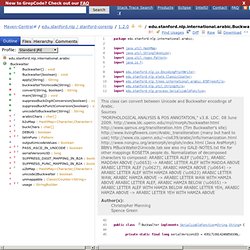
Sources. Buckwalter (Stanford JavaNLP API) Sibawayh Repository for Arabic Language Processing. Language resources and tools for the Arabic language are important for the improvement of Arabic natural language processing.
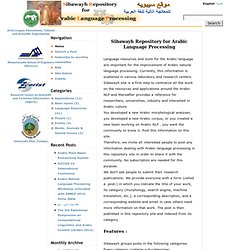
Currently, this information is scattered in various laboratory and research centers. Sibawayh site is a first step to centralize all the work on the resources and applications around the Arabic NLP and thereafter provides a reference for researchers, universities, industry and interested in Arabic culture. You developed a new Arabic morphological analyser, you developed a new Arabic corpus, or you created a new team working on Arabic NLP . you want the community to know it. Description Sibawai. Sebawai Software. AQMAR. Arabic-tagger/featExtract at master · nschneid/arabic-tagger. Center for Computational Learning Systems @ Columbia University. A System for Arabic Tokenization, Diacritization, Morphological Disambiguation, POS Tagging, Stemming and Lemmatization [1] Much work has been done on addressing different specific natural language processing tasks for Arabic, such as tokenization, diacritization, morphological disambiguation, part-of-speech (POS) tagging, stemming and lemmatization.
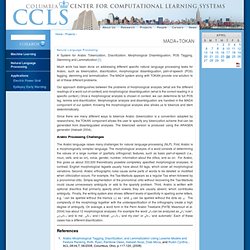
The MADA system along with TOKAN provide one solution to all of these different problems. Our approach distinguishes between the problems of morphological analysis (what are the different readings of a word out-of-context) and morphological disambiguation (what is the correct reading in a specific context.) Once a morphological analysis is chosen in context, we can determine its full POS tag, lemma and diacritization. MADA+TOKAN. MADA - Requirements. SVMTool. SVMTool Here you can find information about the SVMTool, an open source generator of sequential taggers. The SVMTool has been developed at TALP Research Center NLP group , in Universitat Politècnica de Catalunya. The SVMTool is a simple and effective generator of sequential taggers based on Support Vector Machine.
We have applied the SVMTool to a number of NLP problems, such as Part-of-speech Tagging and Base Phrase Chunking, for different languages. The proposed SVM-based tagger is robust and flexible for feature modelling (including lexicalization), trains efficiently with almost no parameters to tune, and is able to tag thousands of words per second, which makes it really practical for real NLP applications. The SVMlight software implementation of Vapnik's Support Vector Machine [Vapnik, 1995] by Thorsten Joachims has been used to train the models. Through this web site you will be able to download the SVMTool software.
Development. SRILM Toolkit. Arabic Morphological Analyzer. SAMA 3.1. SAMA 3.1 @ LDC. Introduction The LDC Standard Arabic Morphological Analyzer (SAMA) Version 3.1 was developed by researchers at LDC. SAMA 3.1 is based on, and updates, Buckwalter Arabic Morphological Analyzer (BAMA) 2.0 (LDC2004L02), which was developed by Tim Buckwalter. Since this is the first public release of SAMA, it has been numbered continuously to reflect the continuity between this release and previous BAMA releases. SAMA 3.0. BAMA 2.0. BAMA 2.0 @ LDC. Introduction This file contains documentation on the Buckwalter Arabic Morphological Analyzer Version 2.0, Linguistic Data Consortium (LDC) catalog number LDC2004L02 and ISBN 1-58563-311-9. Note: This release, unlike Version 1, is available only to LDC members. To find out how to join, please consult our FAQ. There are additional licenseing terms that apply.
To examine the license, please follow the Member License Online link above. Data The data consists primarily of three Arabic-English lexicon files: prefixes (548 entries), suffixes (906 entries), and stems (78,839 entries representing 40,219 lemmas). Samples To see an example of the analyzers output, please examine this sample. Availablity. Aramorph 1.2.1 / BAMA 1.2.1. AraMorph - Browse /aramorph/1.2.1. BAMA 1.0. BAMA 1.0 @ LDC. Introduction Buckwalter Arabic Morphological Analyzer Version 1.0 was produced by Linguistic Data Consortium (LDC), catalog number LDC2002L49 and ISBN 1-58563-257-0. The Buckwalter Arabic Morphological Analyzer is used for POS-tagging Arabic text. Data The data consists primarily of three Arabic-English lexicon files: prefixes (299 entries), suffixes (618 entries), and stems (82,158 entries representing 38,600 lemmas). The lexicons are supplemented by three morphological compatibility tables used for controlling prefix-stem combinations (1,648 entries), stem-suffix combinations (1,285 entries), and prefix-suffix combinations (598 entries).
Updates There has been a case mismatch in the manner by which six files were named in the data, compared with their names in the documentation and the script, which caused the analyzer to crash on case sensitive systems. Content Copyright. MADA (V.3.2) MS-11S-2. About MADA+TOKAN Roth, Ryan, Owen Rambow, Nizar Habash, Mona Diab, and Cynthia Rudin. Arabic Morphological Tagging, Diacritization, and Lemmatization Using Lexeme Models and Feature Ranking. MADA Distribution. MADAMIRA: A new version of MADA, called MADAMIRA, is now available. It is entirely rewritten in Java and requires only the SAMA database mentioned below, but not SVMTools or the SRI Toolkit. Présentation de MADA+token. Manuel MADA+token. Free software downloads. SourceForge.net: Alkhalil Morpho Sys - Project Web Hosting - Open Source Software. ElixirFM Online Interface.
Welcome to the online interface to ElixirFM, the implementation of Functional Arabic Morphology written in Haskell and Perl. Buckwalter Arabic Morphological Analyzer. Téléchargement Aramorph. BAMA 1.0. BAMA 1.0 @ LDC. Présentation du projet. Free Science & Engineering software downloads. Arabic Analyzer for Java - CVS Repositories [Savannah] Arabic Analyzer for Java - CVS Repositories Browsing the CVS Repository You can Browse the CVS repository of this project with your web browser. This gives you a good picture of the current status of the source files.
You may also view the complete histories of any file in the repository as well as differences among two versions. Browse Sources Repository Getting a Copy of the CVS Repository Anonymous CVS Access This project's CVS repository can be checked out through anonymous CVS with the following instruction set. Buckwalter Arabic Transliteration. Buckwalter-fst - An FST implementation of Tim Buckwalter's Arabic morphological analyzer.
AraComLex. Center for Computational Learning Systems @ Columbia University. AMIRA is a successor suite to the ASVMTools.